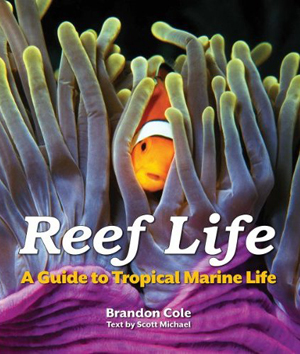Reef Life: A Must-Have Guide to Tropical Marine LifeContents of this Issue: Snorkel with Manatees, Homosassa, Florida Can Someone Give Us the GPS Coordinates to This Dive Site? Reef Life: A Must-Have Guide to Tropical Marine Life The Decline of Dive Training: Part I Cabo Pulmo: Credit Card Theft and Charming Casitas Untrained Divers Have No Place in Dangerous Caves Two Deaths at One of Indonesia’s Most Dangerous Dive Sites Can Nitrox Damage Blood Vessels? Foreign Travel Is Killing Our Dive Stores Editorial Office: Ben Davison Publisher and Editor Undercurrent 3020 Bridgeway, Suite 102 Sausalito, CA 94965 from the March, 2014 issue of Undercurrent
You see, it's the clear and descriptive text that makes this guide special. For example, there are sections on anti-predation behavior (that is, staying off other fishes' menus), mimicry, schooling, cleaner fish behavior, food habits . . . all kinds of useful factoids about tropical reef fish. You'll learn that the indigo hamlet eats blue chromis, that the male redbar anthias chases other males away "to defend its harem," the humphead wrasse returns every night to its preferred sleeping site, the great barracuda can hit 36 m.p.h., and tuna prey on seahorses. There's nothing better than sitting around a table with your fellow divers and being able to spin these stories. There aren't as many fish listed here in comparison to the entire Humann series, but in this paperback volume (6.5" x 7.5"), photos of 400 ray-finned fishes are featured with brief but solid descriptions, as well as sharks and rays, invertebrates, turtles, crustaceans,, corals, marine mammals and ecosystems. Co-authors Brandon Cole, a marine biologist whose photos have appeared in National Geographic and Scientific American, and Scott Michael, a writer and researcher who has consulted for the Discovery Channel and the National Geographic, Channel, logged thousands of hours underwater to produce this fine paperback guide. Within its 616 pages, you will find (besides the 400 fish identified), 1,000 photographs, maps and descriptions of all the tropical diving areas -- Maldives, Florida, Caribbean, Indonesia and everywhere else. I'm certain you'll find this a great book to peruse at your leisure or use for serious research. Click on the book's info listed on our homepage ( www.undercurrent.org ) to buy it on Amazon.com (where it's listed at about $23), and we'll get about five percent of the sales price, which we will then donate to preserve coral reefs and the oceans we love (we gave away more than $3,000 last year). |

I want to get all the stories! Tell me how I can become an Undercurrent Online Member and get online access to all the articles of Undercurrent as well as thousands of first hand reports on dive operations world-wide
| Home | Online Members Area | My Account |
Login
|
Join
|
| Travel Index |
Dive Resort & Liveaboard Reviews
|
Featured Reports
|
Recent
Issues
|
Back Issues
|
|
Dive Gear
Index
|
Health/Safety Index
|
Environment & Misc.
Index
|
Seasonal Planner
|
Blogs
|
Free Articles
|
Book Picks
|
News
|
|
Special Offers
|
RSS
|
FAQ
|
About Us
|
Contact Us
|
Links
|
3020 Bridgeway, Ste 102, Sausalito, Ca 94965
All rights reserved.

 What? Another fish ID book when you thought
Paul Humann's and Ned Deloach's were enough? Yes
indeed, and while I rarely say this, Reef Life: A Guide
to Tropical Marine Life is a must-have for the library of
every traveling diver. And if you only want one ID
book, this is it.
What? Another fish ID book when you thought
Paul Humann's and Ned Deloach's were enough? Yes
indeed, and while I rarely say this, Reef Life: A Guide
to Tropical Marine Life is a must-have for the library of
every traveling diver. And if you only want one ID
book, this is it.